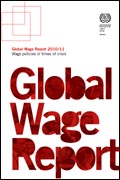Studies in this week’s Hutchins Roundup find raising the minimum wage does not lower employment, public incentives increased and sped up COVID-related R&D, and more.
Want to receive the Hutchins Roundup as an email? Sign up here to get it in your inbox every Thursday.
Increases in minimum wage positively affect wages but have no negative impact on employment
Examining more than 170 state-level minimum wage increases between 1979 and 2019, Doruk Cengiz of OM Partners, Arindrajit Dube of the University of Massachusetts, Amherst and co-authors find little evidence that raising the minimum wage reduces employment. The authors use machine learning techniques to identify those workers most likely to be affected by the minimum wage—a technique that allows them to assess the effect of the minimum wage on a large fraction of low-wage workers, they say, rather than only specific sub-groups with high exposure such as teens or youth. They find that increases in the minimum wage raise the average wage of those affected by them, but have no negative effects on employment, the unemployment rate, or labor force participation.
Public institutions and incentives greatly increased number of COVID-related clinical trials
Ruchir Agarwal of the IMF and Patrick Gaule of the University of Bath find that pharmaceutical research and design typically follow what they call a “law of diminishing efforts”: a 1% increase in the market size of the disease (defined as its national mortality risk, weighted by income) is associated with an increase in the number of clinical trials of only 0.5%. COVID is an exception, inducing seven to twenty times more clinical trials than this historical relationship would imply. Global pharmaceutical innovation scaled up flexibly to accommodate the COVID response, with little crowding out of research on other diseases and overall new trials increasing by 38% in 2020. Much of this response occurred via public research institutions, however, which accounted for 70% of all COVID trials globally and were 10 percentage points more likely than private firms to conduct a COVID trial. Trials in the U.S. and China, where the policy response included early incentives for vaccine development, were on average two months faster than in other countries. These findings suggest that global pharmaceutical innovation has room to grow, the authors say, but that government incentives and support from public research institutions will play a crucial role in supplementing the private response.
European corporations tailored their bond issuance to take advantage of ECB’s bond buying
After the European Central Bank (ECB) announced its corporate bond-buying program in 2016, eligible firms didn’t increase their total borrowing in response, find Stefano Pegoraro of University of Notre Dame and Mattia Montagna of the ECB. Instead, they substituted about $4.5 billion per month of eligible bonds for ineligible bonds, issuing fewer short-term bonds and commercial paper and more fixed-coupon bonds. By meeting the ECB’s increased demand for eligible bonds with increased supply, the authors say, firms prevented a price premium for eligible bonds relative to ineligible bonds. Furthermore, the bond buying program increased investors’ appetite for risk, which lowered the cost of borrowing for both eligible and ineligible firms. In other words, the benefits of the ECB’s corporate bond-buying had substantial spillover effects on the broader market that can’t be seen by looking only at the prices of the bonds the central bank bought.
Chart of the week: Personal income spiked early in pandemic, but consumer spending plummeted
Quote of the week:
“[W]ealth represents a cumulative impact of inherited resources…. It’s a reflection of family circumstances. It can be luck, but it also reflects obstacles in the labor and financial markets. And so that Black-white wealth gap in particular can be attributed to a history of discriminatory policies such as redlining. And importantly, this legacy continues to replicate itself generation to generation as those without accumulated wealth cannot pass it on to their children…” says Cecilia Rouse, nominee for Chair of the Council of Economic Advisors.
“These differences are consequential. Wealth is protective and is important for well-being. Increased wealth has been associated with better health outcomes and better financial resilience. And during this pandemic, what we’ve seen is that those with greater wealth had more resources to fall upon when the economy slowed. So, it provides a kind of self-insurance against economic adversity. It also provides access to housing in safe neighborhoods with good schools, which confers additional advantages on those who can afford such opportunities. Closing the wealth gap is not about trying to literally take away [wealth], but it’s trying to ensure that everybody can participate in this economy.”











Commentary
Hutchins Roundup: Minimum wage increases, pharmaceutical R&D, and more
February 4, 2021